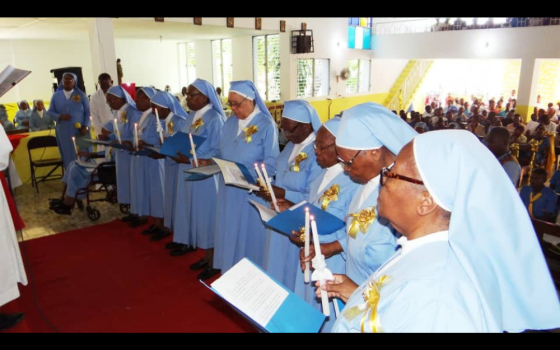After years of living almost on the White House front lawn, Ellen Thomas looked up and spotted then-President George H.W. Bush and his wife Barbara walking toward her anti-nuclear encampment on the edge of Lafayette Square. It was finally a chance to make personal contact with the man she had been beckoning for years -- day-in and day-out. Thomas also had a story to tell the president.
"I was hoping they would stop and talk because I wanted to tell Barbara that my stepfather, Jack Stephenson, had danced with her in dancing school in Rye, New York, when they were kids," Thomas said. "And he told me I could never write her about it, but if I ever met her face-to-face I could tell her, so I was hoping to do that and also of course ask them what they thought about nuclear weapons."
Before she got her chance, Thomas recalled what happened next. Concepcion Picciotto, who also lived in the encampment, spotted the Bushes too. "Connie comes running up with her arm raised up like Hitler's salute, going, 'Heil Bush, Heil Bush, Heil Bush' in her squeaky voice the way she did, and Barbara set her jaw and started walking really fast and that was the end of that visit."
Picciotto, 80, who spent three decades living year-round in the encampment, died Jan. 25 in a D.C. housing facility that supports homeless women. Media reports say she had recently suffered a fall, but her specific cause of death was not mentioned in her obituary in The Washington Post.
Picciotto, a Spanish immigrant, who said her grandfather died at the hands of Franco, may be the last in a not-so-long line of hardcore anti-nuclear protesters who took up residence at the encampment along Pennsylvania Avenue. The Post referred to her as the "primary guardian" of the witness that kept her exposed to Washington's brutal winters and scorching summers for more than 30 years. It was clearly not a venture for the faint of heart. Under National Park Service rules, the wooden lean-to-like structures occupied by the activists could not be left unattended. If they were, police would sometimes move in and dismantle them.
The Post obituary said the encampment "evolved into a well-recognized feature of the city’s landscape. The makeshift shelter became a regular stop for D.C. tour guides and a topic of discussion in local college classrooms. The vigil and its keepers made a cameo appearance in Michael Moore’s 2004 political documentary film 'Fahrenheit 9/11' and starred in another feature-length documentary, 'The Oracles of Pennsylvania Avenue.'"
Thomas, who spent 18 years at the vigil with Picciotto -- along with the group's founder (and Ellen Thomas' late husband) William Thomas -- said Picciotto was a proud woman who did not really like people, but she was devoted to the cause of disarmament and world peace. Ellen Thomas, who vigiled with Picciotto from 1984 until 2002, said her husband, who died in 2009 at age 61, depended on Picciotto's loyal support of the venture.
"One day they were both arrested, and they teamed up for security," Ellen Thomas said. "Thomas painted the signs and wrote essays and legal documents, Connie kept watch and fed and clothed Thomas so he could work and sleep."
Thomas said some tension developed at the encampment when she and William Thomas married, but she disputes any suggestions that she and Picciotto had a "grand feud" of any sort.
"We were friends in our own fashion," Thomas said. "Connie didn't trust or like anybody except Thomas, and she used to nag him all the time. She was not an easy person to live with."
Thomas recalled a night in the late '80s when she and Picciotto shared a quiet moment: "It was a beautiful night and there was nobody around, except her and her signs and me and my signs, and I was struggling to learn how to play the guitar and sing songs that I was writing in my very inadequate voice, and I paused for a minute and then all of a sudden I heard Concepcion singing down the sidewalk. And she was operatic; nobody knew that. She had a glorious voice -- glorious. Yeah, she was something else, and she stuck it out no matter what happened. She was always herself."
Thomas said her upbringing and time spent camping with her family gave her the constitution to endure life living on a sidewalk.
"I loved the outdoors" she said. "I'm an only child, and I therefore learned how to entertain myself, and I liked to read a lot. And I like people. And I really, really, really really want to get rid of nuclear weapons. And I'm creative. You know I painted signs and I carved and I wrote and I stayed very busy and I was deeply, deeply, deeply in love with Thomas and still am.
"I live life one day at a time, and I think that's how Connie lived it too," Thomas continued. "That's all you can do when you're out there, you know. You can't plan for the future because the future depends on the rest of humanity making sense, and that's pretty unlikely."
When someone asked Picciotto: "If by some strange miracle we manage to succeed at getting rid of nuclear weapons what would you do then? She said, 'I don't know,'" Thomas recalled. In part, Thomas asked herself that question, and she decided to leave the encampment in Picciotto's able hands. "If she was there, I could go do other things and double the impact," she said.
Thomas said Picciotto "was raised in a nunnery so she had very strict standards -- extremely strict standards. She felt most comfortable with nuns."
A soft-spoken mother of two adult children, Thomas has remained loyal to the cause of nuclear disarmament. She is at present "on a roadtrip" to promote H.R.1976 -- the Nuclear Weapons Abolition and Economic and Energy Conversion Act of 2015. (NCR spoke to Thomas by phone during a stop in California.)
Since Picciotto's death Thomas' Facebook page has been filled with condolences and tributes. When she suggested to one loyal supporter of the White House encampment, that they could donate items from the venture to a museum, she was rebuked. Some have expressed interest in keeping the vigil going, she said. "It's up to the community to decided whether or not to keep the signs there, and I hope you do," she told the supporter. "That's all I can say. I don't live there anymore."
In addition to Bush, the Berrigan brothers, Elizabeth McAllister, Carl Sagan, Ted Turner ("several times. He always came by in the evening, slightly tipsy," Thomas said) and former President Bill Clinton stopped by the encampment. (A short-term substitute was the only one there to greet Clinton, Thomas said.)
Thomas said the elder Bush did actually make an important passing comment that time he passed by. "I guess Bush wanted to tell us something," Thomas said. "And Bush senior turned to the cameras and he says, 'We see you. We know you're here. We share your views on nuclear weapons.' And that was on CNN, broadcast several times that day."
Thomas said she has been displeased with some of the accounts of Picciotto's life she has read since her death, some "stories questioning her sanity and stuff. She made all sorts of sense. She may not have been a very friendly person, but she made all sorts of sense. She was angry about the right things."
[Patrick O’Neill is a longtime NCR contributor.]


